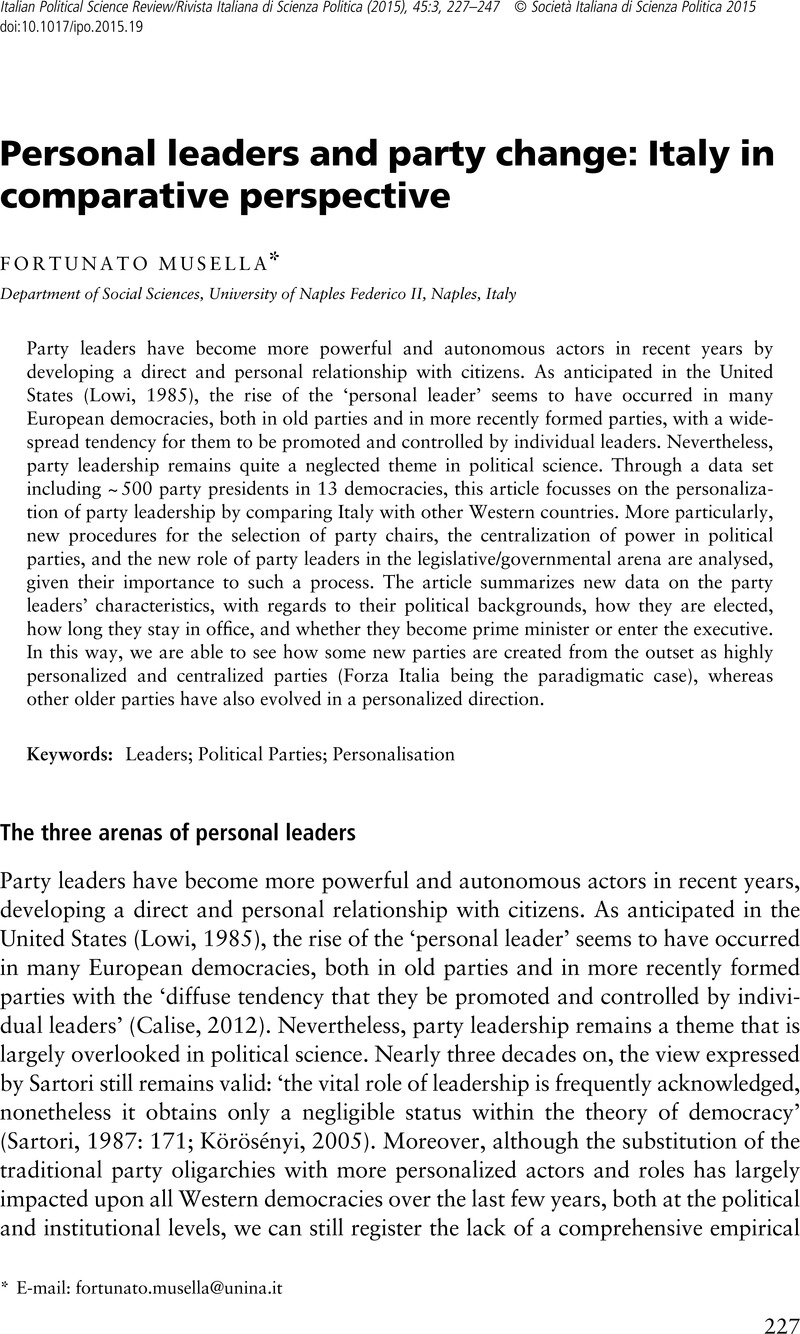Crossref Citations
This article has been cited by the following publications. This list is generated based on data provided by Crossref.
Calise, Mauro
2015.
The personal party: an analytical framework.
Italian Political Science Review/Rivista Italiana di Scienza Politica,
Vol. 45,
Issue. 3,
p.
301.
Fasano, Luciano M.
and
Seddone, Antonella
2016.
Selecting the leader, Italian style.
Contemporary Italian Politics,
Vol. 8,
Issue. 1,
p.
83.
Ceccarini, Luigi
and
Bordignon, Fabio
2017.
Referendum on Renzi: The 2016 Vote on the Italian Constitutional Revision.
South European Society and Politics,
Vol. 22,
Issue. 3,
p.
281.
Albertazzi, Daniele
Giovannini, Arianna
and
Seddone, Antonella
2018.
‘No regionalism please, we are Leghisti !’ The transformation of the Italian Lega Nord under the leadership of Matteo Salvini.
Regional & Federal Studies,
Vol. 28,
Issue. 5,
p.
645.
Musella, Fortunato
2018.
Political Leaders Beyond Party Politics.
p.
31.
Sandri, Giulia
Seddone, Antonella
and
Venturino, Fulvio
2019.
When Charisma is no Longer Enough. Insights on Populist Parties’ Leadership from the (Northern) League.
Polish Political Science Review,
Vol. 7,
Issue. 1,
p.
80.
Truglia, Francesco Giovanni
and
Zeli, Alessandro
2020.
Spatial analysis of economic and social determinants of vote: the case of the European Parliament and constitutional referendum votes in Italy.
Italian Political Science Review/Rivista Italiana di Scienza Politica,
Vol. 50,
Issue. 2,
p.
173.
Giglioli, M. F. N.
2020.
Plutocratic leadership in the electoral arena: three Mitteleuropean cases of personal wealth in politics.
Comparative European Politics,
Vol. 18,
Issue. 3,
p.
309.
Pansardi, Pamela
and
Pinto, Luca
2020.
Gender penalty and electoral outcomes in the 2018 Italian elections.
Contemporary Italian Politics,
Vol. 12,
Issue. 3,
p.
300.
Siddarth, Divya
Shankar, Roshan
and
Pal, Joyojeet
2021.
‘We do politics so we can change politics’: communication strategies and practices in the Aam Aadmi Party’s institutionalization process.
Information, Communication & Society,
Vol. 24,
Issue. 10,
p.
1361.
Caiani, Manuela
Padoan, Enrico
and
Marino, Bruno
2022.
Candidate Selection, Personalization and Different Logics of Centralization in New Southern European Populism: The Cases of Podemos and the M5S.
Government and Opposition,
Vol. 57,
Issue. 3,
p.
404.
Pagliacci, Francesco
and
Bonacini, Luca
2022.
Explaining The Anti‐Immigrant Sentiment Through a Spatial Analysis: A Study of The 2019 European Elections in Italy.
Tijdschrift voor Economische en Sociale Geografie,
Vol. 113,
Issue. 4,
p.
365.
Luypaert, Jasmien
Lingier, Leen
Bouteca, Nicolas
Vandeleene, Audrey
and
Wauters, Bram
2022.
How many captains for a ship on electoral drift? Limiting the number of leadership candidates in the Flemish Christian-democratic party (CD&V).
Frontiers in Political Science,
Vol. 4,
Issue. ,
Aylott, Nicholas
and
Bolin, Niklas
2023.
Locating power in party leader selection.
Scandinavian Political Studies,
Vol. 46,
Issue. 1-2,
p.
1.
Claessen, Clint
2024.
Accruing career capital: How party leaders with more political experience survive longer.
Party Politics,
Vol. 30,
Issue. 4,
p.
719.
Bennister, Mark
and
Worthy, Ben
2024.
The ‘electoral presidentialization’ of Silvio Berlusconi and Boris Johnson: Chaos, controversy, and lost chances.
The British Journal of Politics and International Relations,
Vol. 26,
Issue. 4,
p.
1231.
Valbruzzi, Marco
2024.
Max Weber meets Silvio Berlusconi’s charismatic parties. The history of a spectacular failure.
Contemporary Italian Politics,
Vol. 16,
Issue. 4,
p.
419.



